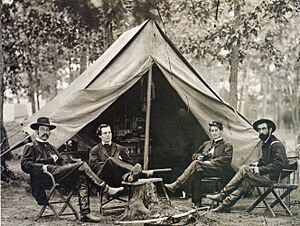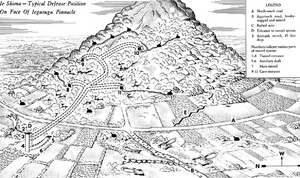Military intelligence facts for kids


Military intelligence is special information about an enemy or a possible enemy. It's not just raw facts; it's information that has been carefully looked at and understood. This information can include details about the land, the weather, and anything else important for a military operation. Gathering military intelligence has been a crucial part of warfare for a very long time.
Contents
How Military Intelligence Started
Early Examples of Spies
People have been gathering intelligence for thousands of years. Around 1274 BC, the Egyptian Pharaoh Ramses II was known to have spies working for him. Even in the Bible, in the Book of Genesis, Joseph thought his brothers might be spies from Canaan.
Ancient Chinese Wisdom
A famous Chinese general named Sun Tzu (who lived from 544 BC to 496 BC) wrote about how important military intelligence is. In his book, The Art of War, he said: "If you know both yourself and your enemy you can win a hundred battles without jeopardy." He really believed in using spies to find out what the enemy was doing and how strong they were.
Sun Tzu also wrote: "All warfare is based on deception." This means that sometimes, by giving the enemy wrong information, you can even avoid a war. This is called counterintelligence. The Romans also relied a lot on intelligence to help them rule their large empire.
Intelligence in the American Civil War
During the American Civil War, Major General Joseph Hooker was in charge of the Army of the Potomac. He asked Colonel George H. Sharpe to create a special intelligence group. In 1863, they started the Bureau of Military Information.
The information they collected was incredibly accurate. For example, they figured out the size of the Confederate Army of Northern Virginia almost perfectly. By the end of the war, Sharpe knew more about the Confederate army than many of their own officers. One of their best sources of information came from enslaved people who escaped the South using the Underground Railroad.
World War I and New Methods
During World War I, intelligence gathering became much more organized. For the first time, airplanes were used to collect information. An observer would fly with a pilot to draw maps of battlefields and take photos of enemy targets. They could even count enemy troops from the sky. Also, operators at special listening stations would listen in on enemy communications.
Important Factors in Military Intelligence
Understanding the Weather
Before the 1900s, accurate weather information was hard to get. Military leaders often didn't know what the weather would be like in the areas they planned to fight. They also often didn't have good maps.
For example, in 1941, when Nazi Germany invaded the Soviet Union, they didn't know how harsh the Russian winters were. They also didn't have good maps of the roads. Between October 1941 and April 1942, the Germans lost over 100,000 soldiers to frostbite. This was a huge number, much more than those killed or missing in action.
Knowing the Land (Terrain)
Knowing about the land, or terrain, has always been vital for military intelligence. Sometimes, environmental factors like mud could change a battle. At the Battle of Agincourt, the very muddy ground slowed down the French army. This made them easy targets for the English archers, helping the English win.
In the 1600s and 1700s, army quartermasters helped provide supplies. They also scouted the land and planned the best routes for the army to take. A big step forward in understanding terrain happened during the Russo-Japanese War (1904–1905). The Russians used geologists to study Korea in detail. These geologists also advised them on building fortifications.
Not knowing enough about the terrain has cost armies many battles. During the Pacific War in World War II, the United States forces knew little about the land on many Pacific islands. After the war, the United States Army Corps of Engineers hired the United States Geological Survey to provide detailed geological information on the occupied islands.
Modern Military Intelligence
Today, military intelligence not only gathers information on other countries but also focuses on terrorism. Looking at communication signals has been a regular part of military intelligence for a long time. Since 2005, military and other intelligence groups have also started watching the Internet.
In some countries today, military intelligence agencies work alongside civilian intelligence agencies. Often, military and civilian groups have different goals. They might gather their own information and not always share it with each other. New ways of gathering intelligence, like video cameras, satellites, reconnaissance aircraft, and drones, create huge amounts of raw data. Artificial intelligence is now used to help analyze all this data to find useful information.
Images for kids
See also
 In Spanish: Inteligencia militar para niños
In Spanish: Inteligencia militar para niños


